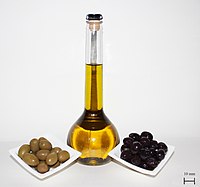
Photo from wikipedia
Thiol‐ene photoinduced copolymerization between a polythiol cross‐linker and low‐grade unsaturated olive oil provides an eco‐efficient route to dry, flexible, and rubbery films in the matter of minutes. The synthetic methodology… Click to show full abstract
Thiol‐ene photoinduced copolymerization between a polythiol cross‐linker and low‐grade unsaturated olive oil provides an eco‐efficient route to dry, flexible, and rubbery films in the matter of minutes. The synthetic methodology uses low cost olive oils resulting from non‐edible grades (lampante olive oil) and waste production (pomace olive oil) without prior chemical modification. The resultant photopolymer thioether cross‐linked films contain up to 80–85% of renewable resources, and UV‐driven drying proceeds despite the limited unsaturations’ concentration. Photopolymerization is triggered with a conventional medium‐pressure mercury arc in presence of three different thiol cross‐linkers: 2,2′‐(ethylenedioxy)diethanethiol, hexanedithiol or trimethylolpropanetris(3‐mercaptopropionate) and a radical photoinitiator (2‐hydroxy 2‐methylpropiophenone). Using real‐time Fourier transform infrared spectroscopy (RT‐FTIR), we show that cross‐linking proceeds essentially via a step‐growth thiol‐ene polymerization, and to a minor extent, by a conventional photo‐oxidation mechanism. Practical Applications: Olive oil is the second largest produced vegetable oil, and in 2016 world production amounted to 3.5 million tons. An excess of low‐grade pomace and lampante olive oils is generated annually from the conventional extraction process; however, declared unfit for human consumption, they have a limited number of uses, and it is difficult to find new outlets. Despite this excess, the development of synthetic and processing methods to convert these non‐edible olive oils in useful materials has not been investigated widely. Here we report a method based on thiol‐ene photopolymerization to prepare a new range of UV‐curable films. Using time‐resolved infrared spectroscopy, this study sheds light into reaction kinetics and polymerization mechanism.
Journal Title: European Journal of Lipid Science and Technology
Year Published: 2017
Link to full text (if available)
Share on Social Media: Sign Up to like & get
recommendations!